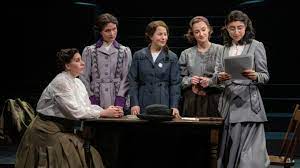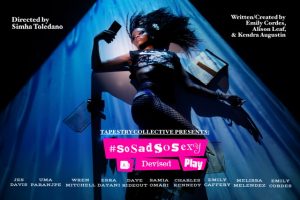
Idiotic fun can be had watching the uneven but nicely acted play To My Girls. A bunch of thirty something gay friends have rented a home in Palm Springs for a weekend of revelry. Bon mots, accusations, heavy drinking and a murder are just a few of the treats in store for those looking for a much lighter weight The Boys in the Band update.
The jokes pour in and cover the expected targets. “On my drive I saw an armadillo that looked like Kelly Ann Conway”. One gets upset when the “orange dipshit” is referenced. He warns “do not say that name in the house; I didn’t pack enough sage”.
The title refers to a toast celebrating these “girls”. In an inspired bit of needling the gender politics of today, the cast addresses the audience and provides a “gender pronoun apology”. They are going to refer to themselves as girls, like it or not. Another quip follows later about being put through the “pronoun ice capades”.
Curtis is the first to arrive having made the reservation. He promptly begins making a blender drink. He pours a little mixer in and then an entire bottle of booze. It’s party time! Curtis is the “A” gay of the group; supremely gorgeous, incredibly narcissistic, extraordinarily slutty and spiraling toward the age of forty. Que tragedie!
Jay Armstrong Johnson is excellent in a role which could be very unlikable. In order for this play to work, the audience must see why the others love this imperfect friend. Maulik Pancholy plays Castor, the self-deprecating one who has always pined for the beautiful boy. One of them notes that “you two are stuck in this Edward Albee play”. Yes this all sounds a trifle cliché but the chemistry on stage makes it work.
The heat seeking juggernaut is the character of Leo who is black and flamboyantly fun. Light racial jokes are tossed around such as “not bottoming for white guys doesn’t make you the gay Frederick Douglass”. Britton Smith is terrific in the role which evolves into the moral center of a play flaunting immorality as a badge of honor.
The girls go to a bar on night one and Castor brings home Omar (Noah J. Ricketts) which turns the plot into a darker yet jovial place. Castor cannot believe Omar would be interested in him. Others are horny. Recriminations will fly! Relationships will be tested! Will there be a happy ending?
JC Lee’s script does spout some messaging meant to empower happiness, self-acceptance, forgiveness and the unshakable bonds created through shared experiences. Then there’s the real debate about which is the best Brittany Spears album.
Snarls at pop culture icons hit the funny bone. “I am only nervous when I watch Taylor Swift do choreography”. A new gay dating app called “Hoopler” is for gays who like basketball. These barbs are more effective than some of the preachy moments about virtue signaling and pointed critiques of a so-called misguided younger generation.
There is a wonderful speech near the end of the play which provides a second meaning for the title of this enjoyable comedy. Many things have changed for the gay community since the pre-Stonewall Boys in the Band was written. Apparently, however, many other things have not. To My Girls certainly showcases gay men in a less closeted way. But the skeletons are still there. And they can be haunting. A trusted group of friends may be the only antidote.
To My Girls is scheduled to run through April 24, 2022 at Second Stage’s Off-Broadway house, the Tony Kiser Theater.










You must be logged in to post a comment.